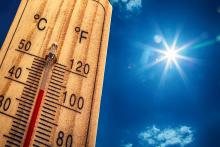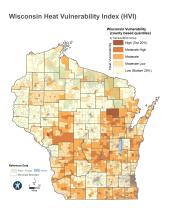Climate and Health: Extreme Heat
Climate change is turning up the heat in Wisconsin. How hot is too hot?
Wisconsin is already experiencing more frequent and intense heat waves as our changing climate becomes warmer and wetter. And, many more severe heat waves are on the way, according to WICCI (the Wisconsin Initiative on Climate Change Impacts).
WICCI predicts an annual increase of 20-30 days with 90-plus degrees Fahrenheit over the next 50 years. Extreme heat is defined as summer temperatures that are much hotter and/or humid than average.
Because some places are hotter than others, the temperature average is different for each location at different times of the year. In Wisconsin, temperatures above 90 degrees Fahrenheit for two or more days in a row are considered extreme heat.
On days when both temperatures and humidity levels are high, your body has to work extra hard to cool off and maintain a normal temperature. Hot, sticky conditions are not only uncomfortable, but they can also cause serious heat-related illnesses and even death. It's important to get prepared, stay informed, and know how to protect your health when extreme heat hits your community.
Learn how to stay safe before the next heat wave hits
Click the headings below to find more information about heat health safety, signs and symptoms of heat illnesses, and ways to cool off on hot days.
Follow these tips to keep yourself and your family healthy and safe on hot, humid days:
- Stay hydrated. Drink plenty of water on hot days. Don't drink beverages high in caffeine, sugar, sodium or alcohol if possible—these cause you to lose more body fluid. Avoid hot, heavy meals too.
- Stay cool.
- Indoors – When possible, stay in air conditioning on hot days. If you don’t have air conditioning, call 211 to find a cool public space like libraries and malls to cool off. Use fans—only if indoor temperatures are less than 90 degrees Fahrenheit—any hotter and a fan can actually increase body temperatures.
- Outdoors – Avoid the hottest part of the day and stick to the cooler morning and evening hours if you have to be outside. Stay in the shade as much as possible, take breaks when you can (in air conditioning if possible), and wear loose, light clothing.
- Check on loved ones. Extreme heat can affect anyone of any age, including youth and adults. Be sure to check on older family, friends and neighbors, especially those who live alone, have chronic health conditions, and don’t have air conditioning.
- Beware of hot cars. Never leave a person or a pet in a parked car, even for a short time. On an 80 degree day, the temperature inside a car can reach 100 degrees in less than 10 minutes.
- Stay informed. Check your local weather forecasts often so you can plan outdoor activities safely. Pay attention to any extreme heat or air quality alerts, the humidity levels, and the overnight temperatures that can increase risks of heat illness.
- Know the symptoms. If your body gets too hot, you can get sick. Learn the signs of your body overheating and when to seek medical care, P-00632 (PDF). Symptoms can include muscle cramping, unusually heavy sweating, shortness of breath, dizziness, headaches, weakness and nausea.
Find more tips to prevent heat illness from CDC (Centers for Disease Control and Prevention).
Heat-related illnesses are preventable. Learn the symptoms and what to do if you or a loved one shows signs of having a heat-related illness.
Heat stroke
What to look for
- High body temperature (103°F or higher)
- Hot, red, dry, or damp skin
- Fast, strong pulse
- Headache
- Dizziness
- Nausea
- Confusion
- Losing consciousness (passing out)
What to do
- Call 911 right away-heat stroke is a medical emergency.
- Move the person to a cooler place.
- Help lower the person's temperature with cool cloths or a cool bath.
- Do not give the person anything to drink.
Heat exhaustion
What to look for
- Heavy sweating
- Cold, pale, and clammy skin
- Fast, weak pulse
- Nausea or vomiting
- Muscle cramps
- Tiredness or weakness
- Dizziness
- Headache
- Fainting (passing out)
What to do
- Move to a cool place.
- Loosen your clothes.
- Put cool, wet cloths on your body or take a cool bath.
- Sip water.
Get medical help right away if:
- You are throwing up.
- Your symptoms get worse.
- Your symptoms last longer than 1 hour.
Heat cramps
What to look for
- Heavy sweating during intense exercise
- Muscle pain or spasms
What to do
- Stop physical activity and move to a cool place.
- Drink water or a sports drink.
- Wait for cramps to go away before you do any more physical activity.
Get medical help right away if:
- Cramps last longer than 1 hour.
- You’re on a low-sodium diet.
- You have heart problems.
Heat rash
What to look for
Red clusters of small blisters that look like pimples on the skin (usually on the neck, chest, groin, or in elbow creases)
What to do
- Stay in a cool, dry place.
- Keep the rash dry.
- Use powder (like baby powder) to soothe the rash.
Sunburn
What to look for
- Painful, red, and warm skin
- Blisters on the skin
What to do
- Stay out of the sun until your sunburn heals.
- Put cool cloths on sunburned areas or take a cool bath.
- Put moisturizing lotion on sunburned areas.
- Do not break blisters.
Some of the following environmental and personal factors may increase your risk of developing a heat-related illness:
Environmental risk factors that can increase body temperature
- High temperatures
- High levels of humidity
- Direct sun exposure
- Lack of wind or breeze
- The built environment like buildings and roads that absorb then give off more heat
- Level and length of physical exertion for outdoor work
Personal risk factors that can increase body temperature
- Not enough time to get used to hot temperatures or humid conditions ( called acclimatization)
- Prior heat illness
- Fever
- Water consumption and dehydration
- Sunburn
- Consuming alcohol, caffeine, sugar or sodium
- A person's age
- Wearing hot clothing that doesn't breathe
- Short-term health conditions:
- Fever
- Diarrhea
- Vomiting
- Respiratory infections
- Poor or variable physical fitness
- Chronic health conditions:
- Obesity
- Heart disease
- Mental illness
- Poor circulation
- Asthma
- Diabetes
- Certain prescription or over-the-counter medications that reduce heat tolerance:
- Cold, allergies, and congestion
- Muscle spasms
- Blood pressure
- Urine production (diuretics)
- Diarrhea
- Dizziness
- Depression
- Insomnia
- Psychosis
Although anyone at any time can suffer from heat-related illness, some people are at greater risk of heat-related illnesses than others, including:
- People 15-34 are most likely to visit the emergency room for heat-related illnesses.
- Infants and children up to four years of age are sensitive to the effects of high temperatures and rely on others to keep them cool and hydrated with enough water or other liquids.
- People 65 years of age or older are less likely to sense and respond to temperature changes. Older adults are most likely to be hospitalized for heat-related illnesses.
- Pregnant people are more likely to get a heat illness because they have to work harder to cool down both the baby and themselves.
- People who push themselves physically during work or exercise may become dehydrated and susceptible to heat sickness.
- Men are about twice as likely to visit the emergency room for heat-related illnesses as women.
- People with chronic conditions, especially heart disease or high blood pressure, or those who take certain medications may be more affected by extreme heat.
- People who are overweight may be prone to heat sickness because of their tendency to retain more body heat.
The Wisconsin Heat Vulnerability Index is an interactive statewide map that can help identify areas and people who are at the greatest risk of heat-related illnesses.
The map and index cover all counties in the state, the greater Milwaukee urban area, and Tribal Nations.
Learn more about the HVI and the online map format.
In 2024, the CDC (Centers for Disease Control and Prevention), NWS (National Weather Service) and other federal agency partners teamed up to create a health-based heat forecast tool, called HeatRisk. This new tool combines data on heat health risks, climate trends, and weather to inform heat forecasts. It provides seven-day heat forecasts that tell people when temperatures and humidity may reach levels that could harm their health and steps people can take to stay safe and healthy. HeatRisk uses a color-based scale with five levels to indicate how dangerous heat levels are in a specific area. Each level uses a color to represent health risks from heat.
HeatRisk considers:
- How unusual the heat is for the time of the year, which makes it more difficult for people to slowly get used to hot and humid temperatures.
- The duration of the heat, including both daytime and nighttime temperatures.
- The elevated health risks from hot temperatures.
CDC’s user-friendly HeatRisk Dashboard integrates the HeatRisk Forecast Tool data with other information including local air quality. By entering your zip code, you can receive customized information on when and how to stay safe if:
- Outdoor temperatures are dangerous.
- Humidity levels are high.
- Levels air pollution are unsafe.
Extreme heat toolkit
Protecting Your Family from Extreme Heat, P-02076, English, Spanish A fact sheet with information about staying safe in an extreme heat event.
Wisconsin Extreme Heat Toolkit, P-00632 (PDF) The comprehensive toolkit provides general information and guidance for extreme heat events, including:
- Definitions of different heat alerts, P-00632a (PDF)
- Information about heat illness and symptoms, P-00632b (PDF)
- Extreme heat tips, P-00632c (PDF)
- Populations vulnerable to heat, P-00632d (PDF)
- Checklists for extreme heat, P-00632f (PDF) This includes long-term preparation, imminent preparation, and response checklists.
- Talking points and message maps, P-00632e (PDF)
Wisconsin heat and climate data
You can view historical climate data and statewide heat-related illness data on the Environmental Public Health Tracking portal. To view county-level heat-related emergency room visit information, find your County Environmental Health Profile.
Heat Stress in Wisconsin: Resources and Opportunities for Action, P-01071 (PDF) This four-page brief covers temperature trends and health effects, risk factors, and strategies for preventing heat-related sickness.
More resources
Milwaukee heat preparedness
In summer 2019, we studied how prepared Milwaukee residents were for an extreme heat event. Learn how we're helping Milwaukee residents prepare for extreme heat.
Extreme heat: Who's at most risk?
In 2019, we partnered with the Minnesota Department of Health to study who is most at risk for heat-related illness. We found young adults are most likely to visit the emergency room for heat-related illness, among other key findings. Find out what we learned about who is at highest risk from extreme heat in Wisconsin and Minnesota, P-02386 (PDF).
Additional DHS resources
- Extreme heat webpage
- Extreme Heat Toolkit
- Air quality and heat information
- DHS Environmental Public Health Tracking Program heat data
CDC resources
- About Heat and Your Health – CDC
- Heat.gov—the National Integrated Heat Health Information System
- Heat and Health Tracker
- Heat and Health Index (select the Heat and Health Index link in the left navigation menu)
- Extreme heat vulnerability mapping tool
- Extreme Heat and Your Health
Occupational Safety and Health Administration (OSHA)
- Heat Illness Prevention for employers and employees who work outdoors or in indoor settings without air conditioning.
- Heat Stress in Outdoor Workers – CDC NIOSH (National Institute for Occupational Safety and Health)
More resources
- 211 Wisconsin—United Way call center for locating cooling centers in Wisconsin
- Heat Safety Tips and Resources – NWS (National Weather Service)
- Extreme Heat – Ready Wisconsin
Spanish language resources
- Preventing Heat Illness in Outdoor Workers – OSHA (Occupational Safety and Health Administration)
- Heat-related materials – Red Cross
Contact us
For more information, email DHSClimate@dhs.wisconsin.gov or call us at 608-266-1120.





